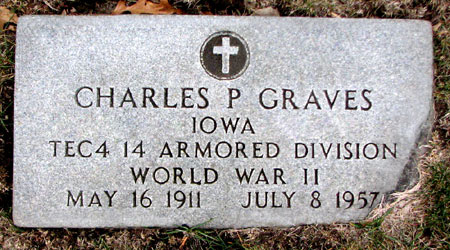| North
High School Wall of Honor Charles Phillip (Jack) Graves Class of January, 1930 |
 |
||||||||||||||||||||||||||||||||||||||||||||||||||||||||||||||||||||||||||||||||||||||||||||||||||||||||||
| Research done by Claradell Shedd, Class of 1953. | |||||||||||||||||||||||||||||||||||||||||||||||||||||||||||||||||||||||||||||||||||||||||||||||||||||||||||
|
|||||||||||||||||||||||||||||||||||||||||||||||||||||||||||||||||||||||||||||||||||||||||||||||||||||||||||
|
|||||||||||||||||||||||||||||||||||||||||||||||||||||||||||||||||||||||||||||||||||||||||||||||||||||||||||
| 14th Armored
Division The 14th Armored Division was constituted and added to the roll of the US Army on 28 August 1942; it was activated on 15 November in a ceremony at Camp Chaffee, Arkansas. It was organized initially as a heavy division with two armored regiments (the 47th and 48th) and one armored infantry regiment, the 62nd Infantry Regiment. It was reorganized from a heavy division to a light division on 20 September 1943. The reorganization saw the loss of two tank battalions from the Armored regiments, one battalion each. The 1st Battalion of the 47th Armor was redesignated as the 786th Tank Battalion and the 3rd Battalion of the 48th Armor was redesignated as the 716th Tank Battlion. The division departed Camp Chaffee in November to participate in the 2nd Army maneuvers in Tennessee from 17 November 1943 until 10 January 1944. At the conclusion of the exercise, the division was assigned to Camp Campbell, Kentucky. The division remained at Camp Campbell until late September when it was alerted for movement to the ETO (European Theater of Operations) via Camp Shanks, New York where it went for final processing. Units departed Camp Campbell on 1 October and completed their arrival at Camp Shanks on the 6th of that month. After completing their processing, the division boarded four transport ships for deployment on 13 October 1944. France and the Alsatian Plain The 14th Armored Division landed at Marseille in southern France, on 29 October 1944. Within two weeks some of its elements were in combat, maintaining defensive positions along the Franco-Italian frontier. The division was assigned to US 6th Army Group on 1 November. On 10 November, the division was assigned to US Seventh Army. On 12 November the Combat Command Reserve (CCR) was detached, and ordered to the Maritime Alps by 6th Army Group to relieve units in defensive positions there. On 15 November, Combat Command A moved north from the area of Marseille to Epinal to take part in the VI Corps drive through the Vosges Mountains, and was followed by Combat Command B five days later. Hard fighting at Gertwiller, Benfeld, and Barr helped VI Corps to crack the German defenses, the division was on the Alsatian Plain in early December. On 17 December the division attacked across the Lauter River into Germany itself, along with the other units of VI Corps, it fought its way into a heavily defended portion of the German Westwall. Due to the growing crisis in the Ardennes, General Eisenhower, the supreme commander, ordered the Seventh Army to stop its attack and withdraw from the Westwall, where its units assumed positions south of the Lauter River. The order was poorly timed as elements of the 14th Armored Division had penetrated deep into the German defenses, and were poised to break out into the enemy's rear. On 25 December 1944 VI Corps ordered the division's Combat Command R, commanded by Colonel Daniel Hudelson, to assemble a regimental-sized task force (TF Hudelson), to establish defensive positions along a 10-mile section of the Seventh Army line linking XV and VI Corps. It was located in the rugged Vosges Mountains in the area of Bannstein in France, southeast of Saarbrücken. The balance of the division was placed in Corps Reserve to protect against a Saar Valley penetration by the Germans. Additionally, it was ordered to be prepared to move to the vicinity of Phalsbourg as a counter-attacking force to stop and prevent a break-through in the XV Corps area. TF Hudelson consisted of the division's 62nd Armored Infantry Battalion, the 94th Cavalry Reconnaissance Squadron and Company A of the 125th Armored Engineer Battalion. TF Hudelson was further reinforced by two VI Corps units, the 117th Cavalry Reconnaissance Squadron and the 1st Battalion, 540th Combat Engineers. Just before midnight on New Year's Eve 1944, the German Army Group G launched Operation Nordwind, the last major German counter-offensive of the war. The advancing German units were from the XC and LXXXIX Corps, attacking through the Low Vosges. TF Hudleson held only a thin line of strongpoints and screens. During the night and day of 1 January 1945, TF Hudelson found itself engaged by elements of five enemy divisions, the 256th, 257th, 361st and 559th Volksgrenadier. Just after midnight on the 1st, the 62nd Armored Infantry reported "enemy attack across the entire front of our battalion zone. The main effort by enemy being made on battalion left flank in the sector of C Co, by estimated 2000 Infantry supported by five (5) Mark IV tanks".[3] The troops of TF Hudelson took the brunt of the German advance which had penetrated to Bannstein by day-break. The Task Force was soon overrun or bypassed by the German divisions but it managed to delay and slow the German advance until substantial reinforcements could arrive and stem the German advance. By the fourth day of the German counter-offensive it had advanced 10 miles. With pressure building during the first day of the attack, aerial observation reported a strong regimental size element moving towards Bannstein. Reinforcements were sent to Baerenthal to reinforce the VI Corps left flank and the 14th Armored Division was ordered to establish blocking positions. On 2 January, the 45th Division along with the attached Task Force, occupied positions to block any further penetration by the Germans. This allowed for the relief of Task Force Hudelson and its return to division control. The major fighting between 1 and 8 January occurred in the Vosges Mountains and two combat commands of the division were in almost continuous action against the German thrusts. With the failure of his attack in the Vosges, the enemy attempted to break through to Hagenau and threaten Strasbourg and the Saverne Gap by attacks at Hatten and Rittershoffen, two small villages located side by side on the Alsatian Plain. However, this, the strongest attack of Operation Nordwind, was halted by the 14th Armored in the fierce defensive Battle of Hatten-Rittershoffen which ranged from 9 to 21 January 1945. Battle of the Bulge The Battle of the Bulge (16 December 1944 – 25 January 1945) was a major German offensive campaign launched through the densely forested Ardennes region of Wallonia in Belgium, France, and Luxembourg on the Western Front toward the end of World War II in Europe. The surprise attack caught the Allied forces completely off guard. United States forces bore the brunt of the attack and incurred their highest casualties for any operation during the war. The battle also severely depleted Germany's armored forces on the western front, and Germany was largely unable to replace them. German personnel, and later Luftwaffe aircraft (in the concluding stages of the engagement), also sustained heavy losses. Different forces referred to the battle by different names. The Germans referred to it officially as Unternehmen Wacht am Rhein ("Operation Watch on the Rhine") or usually Ardennenoffensive or Rundstedt-Offensive, while the French named it the Bataille des Ardennes ("Battle of the Ardennes"). The Allies called it the Ardennes Counteroffensive. The phrase "Battle of the Bulge" was coined by contemporary press to describe the way the Allied front line bulged inward on wartime news maps and became the most widely used name for the battle. The German offensive was supported by several subordinate actions including Operations Unternehmen Bodenplatte, Greif and Währung. As well as stopping Allied transport over the channel to the port city of Antwerp, these operations were intended to split the British and American Allied line in half, so the Germans could then proceed to encircle and destroy four Allied armies, forcing the Western Allies to negotiate a peace treaty in the Axis Powers' favor. Once that was accomplished, Hitler could fully concentrate on the eastern theatre of war. The offensive was planned by the German forces with utmost secrecy, minimizing radio traffic and moving troops and equipment under cover of darkness. Intercepted German communications indicating a substantial German offensive preparation were not acted upon by the Allies. The Germans achieved total surprise on the morning of 16 December 1944 due to a combination of Allied overconfidence, preoccupation with Allied offensive plans, and poor aerial reconnaissance. The Germans attacked a weakly defended section of the Allied line, taking advantage of heavily overcast weather conditions, which grounded the Allies' overwhelmingly superior air forces. Fierce resistance on the northern shoulder of the offensive around Elsenborn Ridge and in the south around Bastogne blocked German access to key roads to the northwest and west that they counted on for success. Columns of armor and infantry that were supposed to advance along parallel routes found themselves on the same roads. This and terrain that favored the defenders threw the German advance behind schedule and allowed the Allies to reinforce the thinly placed troops. Improved weather conditions permitted air attacks on German forces and supply lines, which sealed the failure of the offensive. In the wake of the defeat, many experienced German units were left severely depleted of men and equipment, as survivors retreated to the defenses of the Siegfried Line. The Germans' initial attack included 200,000 men, 340 tanks and 280 other tracked vehicles. Between 67,200 and 125,000 of their men were killed, missing or wounded. For the Americans, 610,000 men were involved in the battle, of whom 89,000 were casualties, including up to 19,000 killed. Along with the Battle of Okinawa and the Battle of Luzon, it was one of the largest and bloodiest battles fought by the United States in World War II. |
|||||||||||||||||||||||||||||||||||||||||||||||||||||||||||||||||||||||||||||||||||||||||||||||||||||||||||
|
|||||||||||||||||||||||||||||||||||||||||||||||||||||||||||||||||||||||||||||||||||||||||||||||||||||||||||
|
|||||||||||||||||||||||||||||||||||||||||||||||||||||||||||||||||||||||||||||||||||||||||||||||||||||||||||
|
|||||||||||||||||||||||||||||||||||||||||||||||||||||||||||||||||||||||||||||||||||||||||||||||||||||||||||
| Died: July 8, 1957. | |||||||||||||||||||||||||||||||||||||||||||||||||||||||||||||||||||||||||||||||||||||||||||||||||||||||||||
| Music: "Wind Beneath My Wings" | |||||||||||||||||||||||||||||||||||||||||||||||||||||||||||||||||||||||||||||||||||||||||||||||||||||||||||
| Home
|
Back/allyears |
WWI |
WWII |
Korea |
Vietnam |
Afghanistan/Iraq |
Lyrics
|
Refs/Awards |
Contact ©2025-csheddgraphics All rights reserved. All images and content are © copyright of their respective copyright owners. |
|||||||||||||||||||||||||||||||||||||||||||||||||||||||||||||||||||||||||||||||||||||||||||||||||||||||||||











